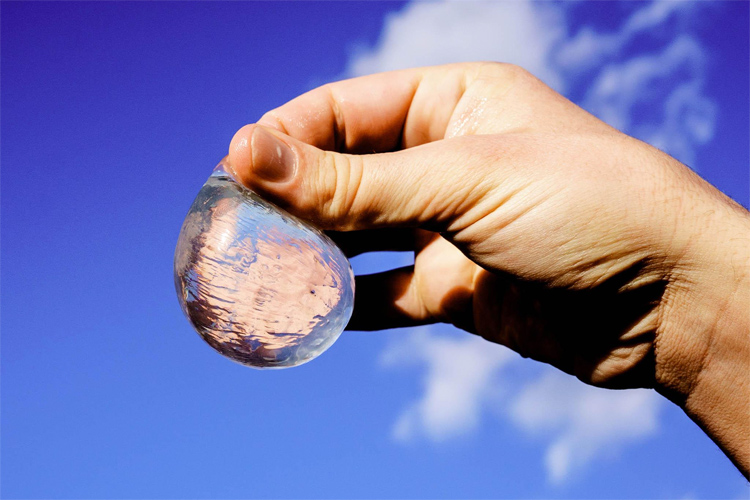An edible water bottle is a transparent sachet made from chloride and seaweed that contains one portion of water inside. It is biodegradable and can actually be eaten.
The prototype named Ooho! was created in 2014 in London by a group of design students. Soon after, Rodrigo Garcia González and Pierre-Yves Paslier co-founded Skipping Rocks Lab.
The startup company quickly raised funds and started improving the properties of the material at Imperial College London.
Ooho!, the edible water blob, can be consumed on a daily basis to replace plastic bottles.
"We can put almost any liquid inside an Ooho! - fresh juices, sauces, condiments, energy and soft drinks, beer, wine, spirits, and even cosmetics," the company notes.
Skipping Rocks Lab says that their proprietary material is already cheaper than plastic.
And while plastic bottles need between 450 and 1,000 years to biodegrade, edible water bubbles only need six weeks on average.
Ooho! aims to help the world get rid of all the plastic waste from cups and bottles. Let us not forget that over one billion plastic bottles reach the five oceans of the world each year.
The edible water blog by Skipping Rocks Lab looks like a gelatinous sphere, and it is safe to consume. But it can also be composted because it is created from brown algae.
The Manufacturing Process
Skipping Rocks Lab uses a well-known culinary technique to produce edible water bottles called "spherification."
The process is relatively simple. All you need to do is mix sodium alginate and calcium chloride until you get a gelatinous membrane that encapsulates water or any other liquid.
Skipping Rocks Lab's innovative manufacturing process can produce several thousands of edible water blobs - from 50 ml to 250 ml - in a single day.
The hydration on-the-go product is suited for music festivals, athletic events, and small street businesses.
For instance: did you know that the London Marathon uses more than 750,000 plastic bottles and that they could be partially or entirely replaced by Ooho!?
The edible water bottle is one of the smartest eco-friendly alternatives to plastic ever invented.
And, from both a business and consumer's perspective, it has everything to be a massive hit in the decades to come.
"The top three reasons we used seaweed for making Ooho! is that it is one of the fastest-growing plants in the world, it naturally biodegrades quickly and because, unlike polylactic acid (PLA) and other corn-based plastics, seaweed doesn't compete with food crops," underlines Skipping Rocks Lab.

The Future of Drinking
The casing has no natural taste, but it can be flavored or colored to meet specific requirements.
To enjoy Ooho!, all you need to do is peel the thicker outer layer like fruit and pop it in your mouth. But you can also bite a hole in it and drink the water without eating the seaweed-based capsule.
Will edible water bottles catch on and prevail? Lucy Ashe used them to win London's 2017 Harrow Half Marathon.
"It takes a little bit of time to get used to, but actually, it's the perfect amount of water that you need to take in a race," says the British runner.
"A whole water bottle is way too much, so this will be able to get us hydrated at exactly the right amount."
Skipping Rocks Lab literally thought outside of the bottle.
The next goal is to develop a machine that is capable of producing hundreds of fresh Ooho! edible water balls per hour so that they can be sold locally by retailers anywhere in the world.
And where can you buy Ooho!? The world-famous edible water blob is already available to purchase in Selfridges.
